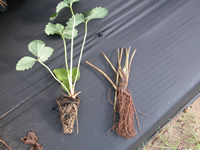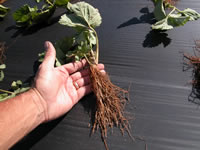Plant Material
go.ncsu.edu/readext?185276
en Español / em Português
El inglés es el idioma de control de esta página. En la medida en que haya algún conflicto entre la traducción al inglés y la traducción, el inglés prevalece.
Al hacer clic en el enlace de traducción se activa un servicio de traducción gratuito para convertir la página al español. Al igual que con cualquier traducción por Internet, la conversión no es sensible al contexto y puede que no traduzca el texto en su significado original. NC State Extension no garantiza la exactitud del texto traducido. Por favor, tenga en cuenta que algunas aplicaciones y/o servicios pueden no funcionar como se espera cuando se traducen.
Português
Inglês é o idioma de controle desta página. Na medida que haja algum conflito entre o texto original em Inglês e a tradução, o Inglês prevalece.
Ao clicar no link de tradução, um serviço gratuito de tradução será ativado para converter a página para o Português. Como em qualquer tradução pela internet, a conversão não é sensivel ao contexto e pode não ocorrer a tradução para o significado orginal. O serviço de Extensão da Carolina do Norte (NC State Extension) não garante a exatidão do texto traduzido. Por favor, observe que algumas funções ou serviços podem não funcionar como esperado após a tradução.
English
English is the controlling language of this page. To the extent there is any conflict between the English text and the translation, English controls.
Clicking on the translation link activates a free translation service to convert the page to Spanish. As with any Internet translation, the conversion is not context-sensitive and may not translate the text to its original meaning. NC State Extension does not guarantee the accuracy of the translated text. Please note that some applications and/or services may not function as expected when translated.
Collapse ▲
The plant on the left is a strawberry plug while the plant on the right is a cut off.
Strawberry plant material is utilized in three forms in North Carolina depending on the strawberry producing region. Plants may be acquired as plugs, fresh dugs and cutoffs. Approximately 55 percent of the strawberries grown in North Carolina are grown from plugs, while 35 percent start as fresh dugs with the remaining 10 percent grown from cutoffs. The mountains, foothills and Piedmont primarily use plugs. In fact, the mountains are restricted to using plugs since the fresh dugs are not available until after their last acceptable planting date. Growers in the coastal plains primarily use fresh dugs. A most southeastern region of the coastal plains can also use cutoffs. These types of plant material are all “fresh” as opposed to dormant. Fresh dugs and cutoffs are bareroot plants, while plugs are runner tips that have been rooted in a peat-based media and feature an intact rootball. The distinction between fresh dugs and cutoffs is that fresh dugs retain the vegetative foliage while the foliage of cutoffs has been mowed prior to digging from the propagation bed. Plugs are the most expensive type of plant material, while cutoffs are the least expensive.
Strawberry plants (runners) are asexually propagated through tissue-culture in a micropropagation lab. The plants are grown out for up to four generations in the nursery. Runners harvested after two years of growth in the field nursery are considered “registered,” while those grown for three years in the field are referred to as “certified.” The most vigorous plants are the first year nursery plants, called foundation or white tag plants; however these are cost prohibitive to producers and serve only as nursery stock. Each year thereafter, there is reduced vigor.
The plugs are rooted in North Carolina from runner tips grown in Canada or western North Carolina. Fresh dugs are grown in Canada and western North Carolina. The Canadian fresh dugs primarily come from two provinces: Prince Edward Island and Ontario. The cutoff plants are all propagated in northern California.
Plugs
Strawberry plugs are nearly twice the cost of fresh dug or cutoff strawberry plants, but they have the advantage of being suitable for mechanical transplanting with a water-wheel or disposable pot mulch planter. Part-time growers, who do not have the time to oversee the continuous overhead watering of fresh dugs during the first week following field transplanting, should use plugs. Also, less experienced growers are encouraged to consider planting plugs because they are more “mistake-proof” than highly perishable, fresh dug plants. Transplanting dates for plugs can also be slightly later than for fresh dugs without as great a yield reduction. This is because plugs establish more quickly than fresh dugs after transplanting. Commercial grower experiences in North Carolina suggests using overhead sprinklings for the first, second and possibly third day following plug transplanting for approximately five hours, three hours and two hours per day, respectively. Drip irrigation has proven to be very important during the fall season to meet the plants water requirement during dry periods in the late fall. Growers should be aware that plug orders need to be placed by early to mid-June to ensure availability.
Fresh dugs

The fresh dug strawberry plant is bareroot, with the shoots still intact.
Freshly dug plants, commonly referred to as fresh dugs, are most often transplanted by hand requiring an availability of affordable labor. To establish these highly perishable fresh dugs, growers must rely on intense overhead sprinkling for one to two weeks, depending on weather and the condition of the freshly dug plants. Fresh dugs must be irrigated within 30 minutes of planting. Fresh dugs exposed to cooler temperatures, chilling in the nursery or both will require less time for establishment than fresh dugs produced in warmer climates. Fresh dugs are not usually available until the final week of September, and this is too late for transplanting in colder regions (the upper Piedmont, foothills, and mountains of North Carolina). However, if good quality fresh dugs can be obtained in the third week of September, growers in warmer sections of USDA Hardiness Zone 6 may wish to evaluate fresh dugs from the standpoint of their relative cost savings and the possibility of enjoying a longer harvest season.
Cutoffs
Another type of transplant, called a “cutoff” is available by the second to third week of October from northern California nurseries. These have accumulated considerable chilling in the nursery and have been mowed prior to digging and harvest. Cutoffs are only recommended for the very mildest winter areas in southeastern North Carolina. Cutoffs should be ordered by the end of June.


